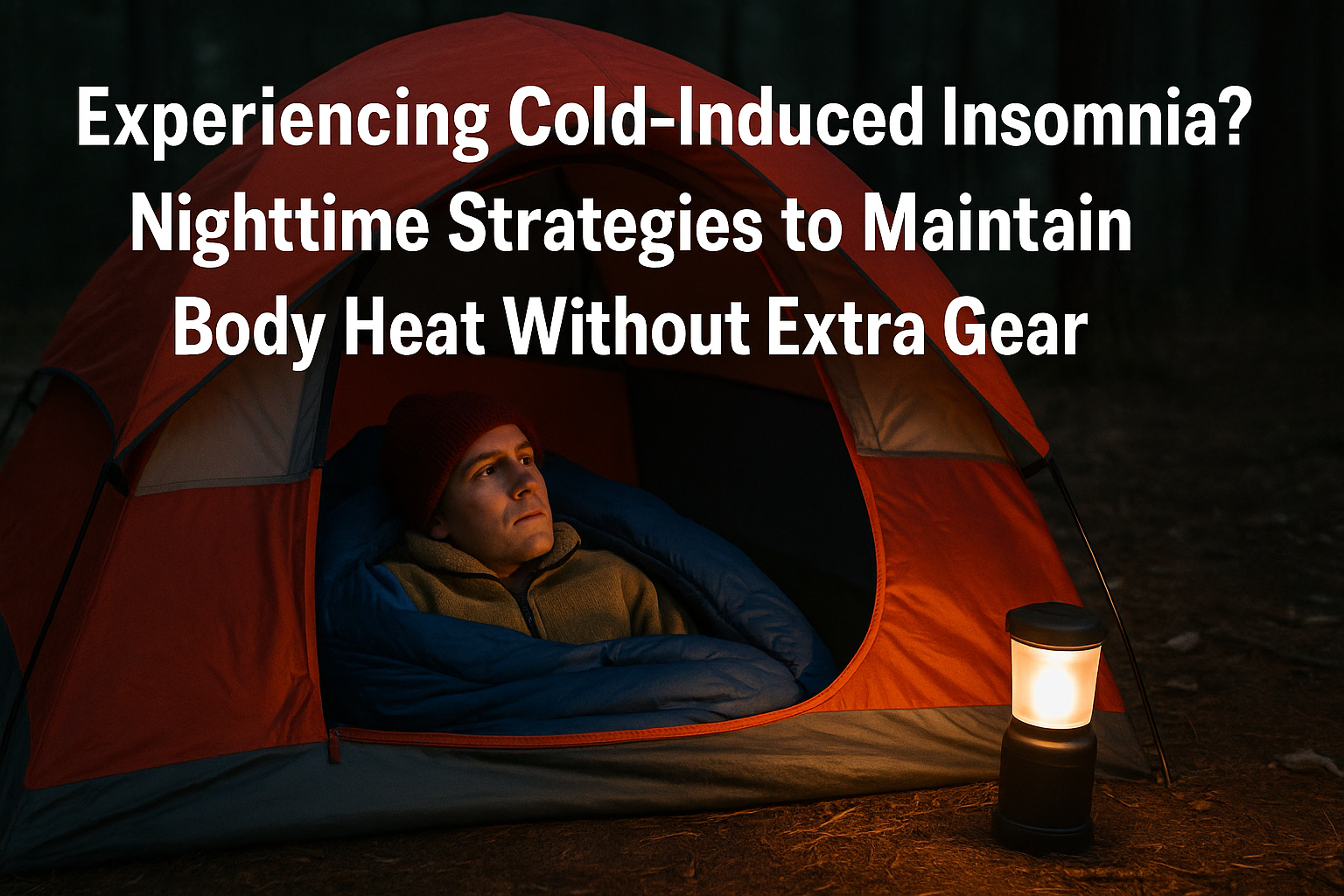You’ve zipped your bag tight.
You’re wearing every layer you brought.
But you’re still wide awake.
The cold creeps in—not enough to kill you, just enough to keep your body on alert.
It’s 3 a.m. and your mind is spinning while your toes are numb.
This is cold-induced insomnia.
And in survival or remote camping, it’s more than uncomfortable—it’s dangerous.
🔍 Why Cold-Induced Insomnia Happens
Sleep studies (see: NIH Sleep Physiology in Extreme Environments) show that core body temperature naturally drops at night to initiate sleep. But when the environment is already freezing, your body can’t afford to let go of warmth.
So it keeps you awake, shivering, and stuck in a sympathetic nervous state (fight or flight mode).
If your body doesn’t feel safe enough to drop temperature, it won’t let you fall asleep.
And without sleep? You lose decision-making, reaction time, and thermoregulation—the exact things you need to survive in the cold.
✅ Rules for Solving Cold Insomnia Without More Gear
To sleep warm without extra equipment, you need to:
- Boost internal heat
- Minimize heat loss through breath, ground, and air gaps
- Use your body strategically like a furnace
Let’s break down non-obvious, real-field fixes to help you sleep warm with what you already have.
🧠 1. Pre-Sleep Warm-Up: Trick Your Core Into Relaxing
🔥 Why it works:
Raising your core temp right before sleep triggers the natural drop needed to enter deep rest—even if the environment is cold.
🚶 What to do:
- 60 seconds of high-intensity isometric movement inside your shelter (squats, planks, jumping jacks)
- Keep it brief: don’t sweat
- Crawl into your sleep system immediately after movement to trap that generated heat
🧠 Think of this like “preheating” your body the way you would a sleeping bag.
🍫 2. Caloric Thermogenesis: Fat and Carb Combo Before Bed
Your body burns food like fuel—and in cold, it prioritizes warmth over digestion.
Best pre-sleep combos:
- Spoonful of nut butter + small piece of dark chocolate
- Tortilla wrap with olive oil + protein
- Hard cheese and dried fruit
Avoid: Sugary snacks alone. They spike blood sugar and crash your warmth later.
🧠 Studies from polar expeditions show fat-dense meals increase overnight survival success rates in extreme cold.
🧤 3. Buffer Heat Escape Points Using Your Gear
You don’t need more gear—just smarter placement of what you already have.
Cover these zones:
- Neck: Stuff a dry buff or shirt into the collar gap of your sleeping bag
- Armpits: Lay gloves or dry socks in your armpits (keeps hands warmer too)
- Crotch: Place an empty dry bag or pouch here to trap heat (or wrap legs around it)
- Feet: Layer unused clothes over toes outside your bag’s footbox
🔥 The goal is to stop heat from leaking at known high-radiation zones.
💨 4. Manage Your Breathing Zone to Prevent Condensation Cold
Breathing cold air all night?
It chills your lungs and dampens your bag—both killers of warmth.
Do this:
- Sleep with a buff lightly over nose and mouth
- Angle face slightly downward and into bag collar, but not sealed
- Avoid breathing inside the sleeping bag—condensation ruins insulation
🧠 This reduces both respiratory heat loss and cold vapor damage.
🛏️ 5. Sleep In This Position to Maximize Heat Retention
Best cold-sleep position:
- On your side, curled slightly into fetal
- Knees pulled in, arms tucked across chest or between thighs
- Back to the wall (if sheltering against something)
Why?
- Reduces surface area exposure
- Centralizes blood flow
- Protects vital organs from cold drafts
🧠 The fetal position is biologically designed to preserve heat.
🧦 6. Strip and Redress Feet Only if They’re Sweaty (Not Just Cold)
Huge mistake:
Wearing damp socks = evaporative cold = guaranteed cold feet.
What to do instead:
- Take off socks right before bed
- Let feet dry for 5 minutes
- Put on dry pair (or warm up socks in armpits first)
🧠 Dry, warm feet reduce total body shivering because your body stops overcompensating for extremity cold.
🔁 7. Use the “Layer Flip” Strategy If You Wake Up Cold
If you wake up at 2 a.m. freezing:
- Get up and move for 1 minute
- Flip your base layer (inside-out if it’s damp)
- Rotate top and bottom socks
Why? Your base layer may be slightly damp from perspiration—even if you didn’t notice.
A dry-feeling layer next to your skin resets heat retention instantly.
🔥 This can add an hour or more of warm sleep without new gear.
🧘 8. Calm the Panic: Breathe into Sleep with the 4-6-8 Pattern
Even in cold survival, mental panic can block your ability to fall asleep.
Use this pattern:
- Inhale for 4
- Hold for 6
- Exhale for 8
It slows your heart, oxygenates you fully, and switches your body from “survive” to “rest.”
🧠 Cold insomnia is often as psychological as physical. If your nervous system doesn’t feel safe, it won’t let go.
🧼 9. Clean Your Core Before Bed (Even Just Your Neck and Chest)
Dirt and sweat = evaporative cooling.
If you don’t have wipes or water, use:
- Dry cloth
- Bandana
- Even the inside of your shirt
Wipe down neck, lower back, and groin—your body’s heat centers.
🔥 Clean skin warms faster and holds insulation better.
🪵 10. Final Trick: Simulate a Hot Water Bottle with Your Own Body
No hot water? No Nalgene?
Use this:
- Blow into an empty dry bag, seal it
- Place it between thighs or at feet
- Your warm breath + insulation keeps the air inside warmer than the outside environment
It’s not a hot bottle—but it’s a warm air battery you can make with nothing but breath.
🧠 This trick is often used in mountaineering bivouacs without stoves.
🎯 Recap: Cold Survival Sleep Without Extra Gear
| Problem | Fix |
|---|---|
| Freezing before bed | Short burst of movement, eat fats |
| Cold feet | Dry sock change + insulated layering |
| Damp breathing zone | Buff + angled face-out |
| Draft leaks | Plug heat zones (neck, pits, crotch) |
| Wake up freezing | Layer flip + dry wipe + fetal curl |
🧭 Final Words
You don’t need fancy gear to sleep warm.
You need field-tested techniques, body wisdom, and the discipline to execute small changes that compound warmth.
The cold isn’t just around you. It’s trying to get inside you.
Your job is to stop it — and fall asleep in command.

